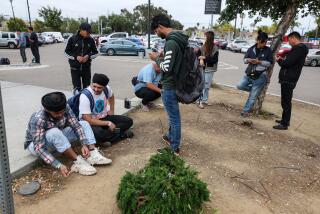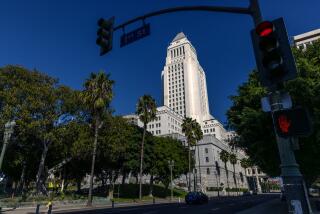Hold, Please
Faced with public opposition from telephone users in the affluent, politically powerful 310 area code region, the state Public Utilities Commission late last month indefinitely postponed a controversial “overlay” area code for the Westside and the South Bay. San Fernando Valley telephone users deserve no less when the question of an overlay for the 818 area code comes before the PUC on Aug. 5.
An administrative law judge for the PUC last week recommended an overlay as preferable to dividing the 818 code geographically. (Telecommunications companies say one or the other is needed because there are not enough numbers to meet demand, but more about this later.) An overlay allows residents and businesses that already have telephone numbers to keep the 818 area code. New lines, even those within the same house or business, would be given a new, as yet undetermined area code. All callers would have to dial the area code plus the number, even for calls to the same area code.
We agree that dividing an area code geographically causes problems. The small businesses that are so vital a part of the Valley economy would bear the expense of printing new business cards and stationery. Those that have spent years promoting their name and phone number in a competitive market might never recover business lost when a customer couldn’t remember a new number and moved on to the next business down the list.
But overlays come with their own problems, beyond the hassle of dialing 11 numbers for even local calls, which is a particular hardship for children and the aged. Security access devices would have to be reprogrammed, as would phones that are rigged to block long distance dialing. Growing businesses or households that added phones would be saddled with different area codes.
Not everyone is convinced we have to choose between the chaos caused by dividing an area code and that caused by an area code overlay. A bill sponsored by Assemblyman Wally Knox (D-Los Angeles) and aptly numbered Assembly Bill 818 directs the PUC to come up with a better plan to meet the need for new phone numbers.
Can a better plan be found? Consider the numbers.
There are an estimated 7.9 million phone number combinations assigned to the 818 area code that serves the Valley. The Valley is home to 1.5 million residents. Even given the proliferation of cell phones, fax machines, modems, pagers and extra phone lines, how can we have used up nearly 8 million numbers?
The answer is: We haven’t. An inefficient national system issues phone numbers in blocks of 10,000. The practice dates back decades before new carriers were allowed to enter the local phone market. Carriers such as small pager companies may need far fewer than the 10,000 numbers issued but are not required to return unused numbers or even report their rate of use.
Fixing the problem will require changes at the federal level, and the Federal Communications Commission has scheduled hearings. But that will take time. Knox’s bill calls for the PUC to seek federal waivers to dole out numbers more efficiently and to reclaim numbers that have not been used. What is needed now is time for these changes to be put in place--the same grant of time the PUC gave consumers in the 310 area code.
Knox’s bill, bolstered by calls from angry consumers, passed the Assembly in late May, despite intense lobbying by the telecommunications industry. It will be taken up by the state Senate Committee on Energy, Utilities and Communications on Tuesday, where it deserves the support of state Sen. Richard Alarcon (D-Sylmar) and other committee members.
Federal and state solutions are in the works--if consumers demand them of their senators and of the PUC.
More to Read
Sign up for Essential California
The most important California stories and recommendations in your inbox every morning.
You may occasionally receive promotional content from the Los Angeles Times.










